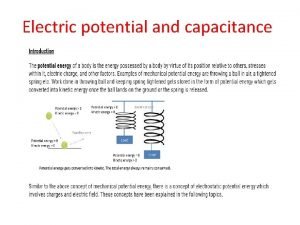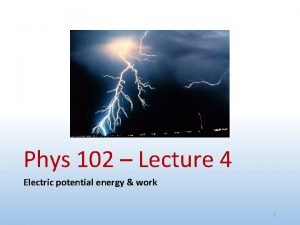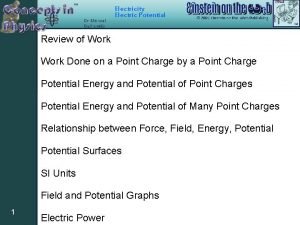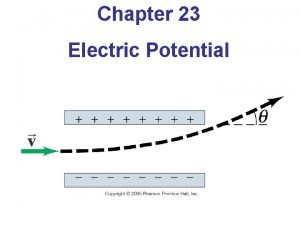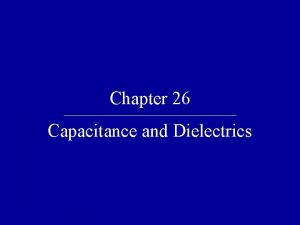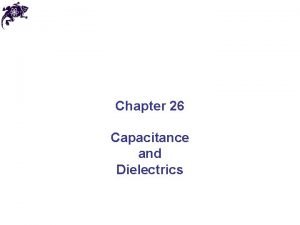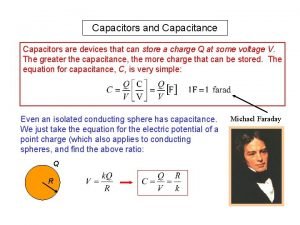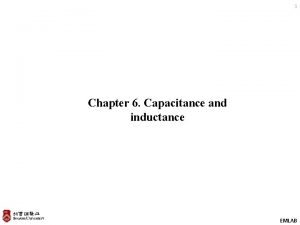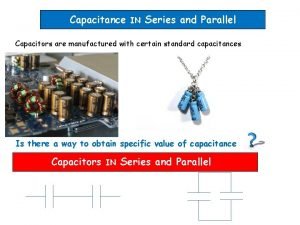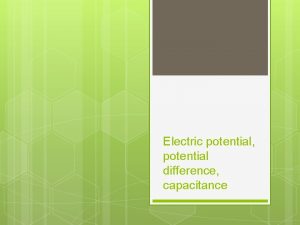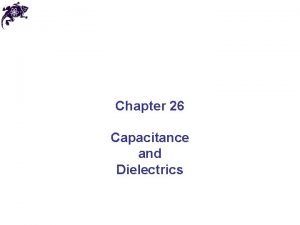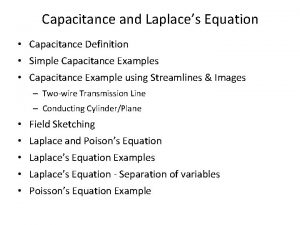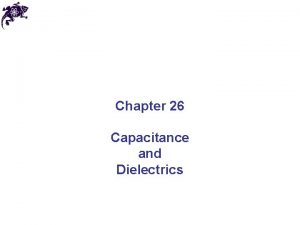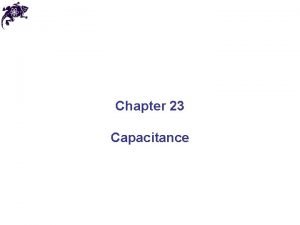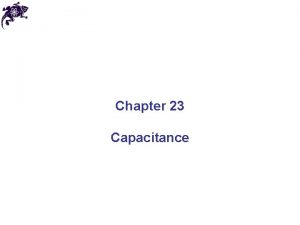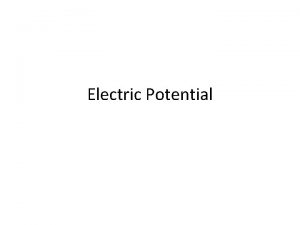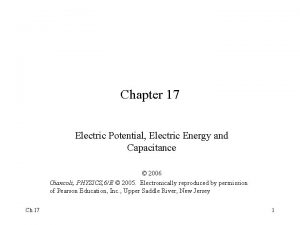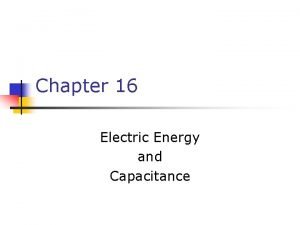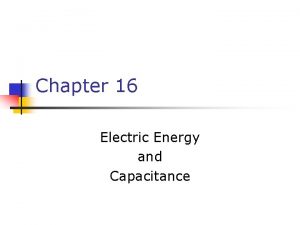Electric Potential and Capacitance Electric Potential and Work


















- Slides: 18

Electric Potential and Capacitance

Electric Potential and Work • So far, we have kept all our charges still • When an object moves in an electric field, it will experience a change in energy- kinetic, potential • Unless its movement is perpendicular to the field, there will be a U • U=-WE • The change in potential energy is the work done by the electric force • Just like we discussed with gravity! • And it’s scalar (hooray)

Electric Potential Energy and Work • • Remember work? W=Fd W=Fer and FE=q. E W=q. Er So U=-q. Er What’s with the -? When the field does work, there is a loss of potential energy • If you put in work through an external source, you can move an object in an electric field against its natural motion and thereby give it potential energy

Electric Potential Energy and Work What if the source charge were negative?

Electric Potential Energy and Work What if you move a charge at an angle to the electric field?

Electric Potential Energy Example • A positive charge, +q, moves from position A to position B in a uniform electric field E. What is its change in electric potential energy? Let’s draw… B r A FE

Solution: U • If you break up the movement into components, ry and rx, the ry component does not change the U since it is perpendicular to the force (remember this from WORK). Only rx component does work and thus changes the U. • U=-WE=-q. Ed where d=rx (only the component that moves parallel to the force) rx B r ry A FE

U: similar to gravity • Like in gravity- U is a way of rating a position in an electric field • Path independent • Depends on distance (like height) • Depends on amount of charge (like mass • In gravity: U=mgh • In electrostatics, we have one more thing to consider- just like g accounts for the source (earth) and m takes into account the object we need to account for the source and test charge

Electric Potential • If we, instead of moving one test charge in an electric field, move 2, 3, or even 10 charges, the potential energy change will be 2, 3, or 10 times as high • Helpful to deal instead with the potential per unit charge

Electric Potential • • Electric Potential=V (often called voltage) Unit is the volt (V) V= U/q (electric potential energy per unit charge) If we assume that V 0 as r ∞ Then we can say V=k. Q/r And it’s scalar (hooray) Check green sheet- it’s written there but you have to find it!

Equipotential Surface: Dashed lines represent places where a test charge would feel the same force

Electric Potential Energy vs. Electric Potential (Voltage) • If you rub a balloon in your hair, you can give it a negative charge- up to several thousand volts!!! • However, there is not a lot of energy involved because the charge is small- around one millionth of a C so the potential energy is only about a thousandth of a Joule

Electric Potential Problem • Let Q=2 x 10 -9 C. What is the potential at a point, P, that is 2 cm from Q? • V=k. Q/r • V=(9 x 109)(2 x 10 -9)/(0. 02)= 900 V

Potential Differences and movement of charges • When a potential difference exists, charges will FLOW • To get a continuous flow, you need to maintain the potential difference- eg through a battery connected with conducting wires • If we set up our parallel plates again, we can create a potential difference. If we connect the plates with a conductor, the charges will flow • What if we separate our plates with an insulator instead?

Capacitor If an insulating material (dialectric) is placed between the plates, you can store static charges to a higher concentration

Capacitance • Capacitance (C) of a capacitor is how much charge it can store: • C=Q/V • Or the ratio of the charge on one plate to the potential difference between them • Constant for each capacitor so as the charge, Q, builds- the voltage difference increases • Unit = farad (F)

Capacitance • OR: for parallel plates C=ε 0 A/d • Where ε 0 is a new constant: vacuum permitivity • A is the area of the plates • D is the separation between plates • So capacitance is directly related to the area of plates • Inversely related to their separation

Why capacitors? • Sometimes you want to build up more charge and discharge it all at once instead of continuously • Example: camera flash
 Electric field lines
Electric field lines Potential and capacitance
Potential and capacitance Equipotential lines
Equipotential lines Electric potential and potential energy
Electric potential and potential energy Electric potential inside non conducting sphere
Electric potential inside non conducting sphere Potential and potential difference
Potential and potential difference Pe=-qed
Pe=-qed Electric field and energy
Electric field and energy Electric potential is
Electric potential is Can potential energy be negative
Can potential energy be negative Electric potential review
Electric potential review Relation between potential energy and electric field
Relation between potential energy and electric field Relation between energy and voltage
Relation between energy and voltage Capacitance and dielectrics quiz
Capacitance and dielectrics quiz Capacitance and dielectrics
Capacitance and dielectrics Capacitance
Capacitance Inductance and capacitance formula
Inductance and capacitance formula Capacitance in series and parallel
Capacitance in series and parallel Hubungan kapasitor dengan tegangan
Hubungan kapasitor dengan tegangan

